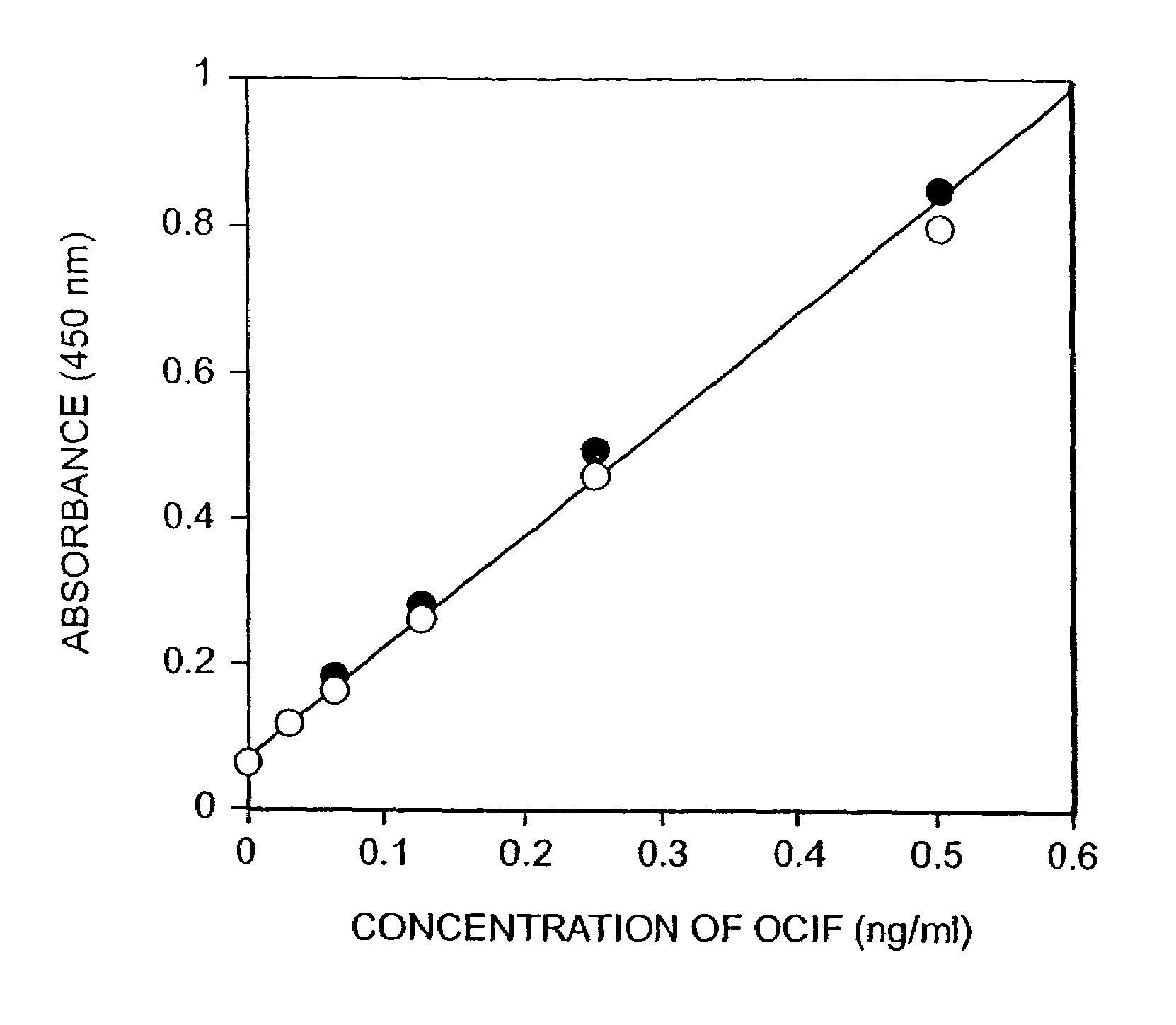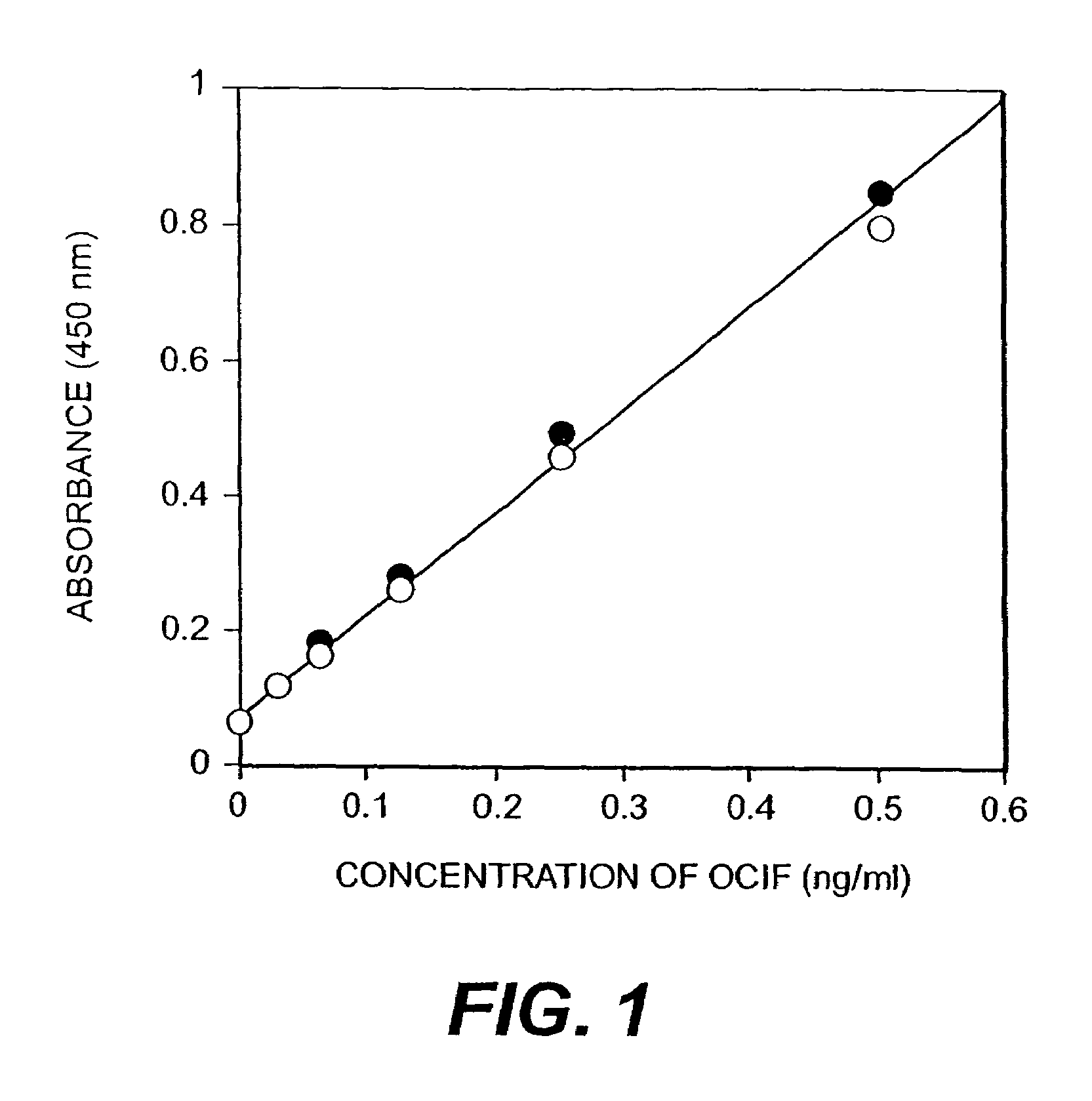Method of diagnosing metabolic bone diseases
- Summary
- Abstract
- Description
- Claims
- Application Information
AI Technical Summary
Benefits of technology
Problems solved by technology
Method used
Image
Examples
example 1
Purification of Monomer Type of OCIF or Homodimer Type of OCIF as an Antigen
[0040]OCIF-producing CHO cells described in WO96 / 26217 were seeded in EX-CELL 301 medium (JRH Bioscience) at a cell density of 1×105 cells / ml and cultured at 37° C. for 7 days using a jar for cell culture (2 liters container). To the obtained culture medium, CHAPS (3-[(3-cholamidopropyl)-dimethylammonio-]-1-propanesul fonate, Sigma) was added to a concentration of 0.1%. After pH of the medium was adjusted to 6.0 by acetic acid, the medium was filtered through 0.22 μm filter (milidisk, Millipore). The culture medium was loaded on a SP sepharose HP column (2.6×10 cm, Pharmacia) equilibrated with 50 mM bis-tris-HCl buffer solution containing 0.1% CHAPS. After washing the column with the same buffer solution, the column was developed with a linear gradient from 0 to 1 M NaCl for 100 minutes at a flow rate of 4 ml / min. and the elute was fractionated into 8 ml each. According to the method described in WO96 / 26217,...
example 2
Immunization of Mice and Preparation of Hybridoma
[0042]Monomer- and homodimer-types of OCIF purified as described in example 1 were dissolved in physiological saline solution to concentration of 100 μg / ml, respectively. To a mixture each containing equal amount of both types of OCIF prepared as above, the same volume of Freund's complete adjuvant was added. The mixed solution was emulsified well and administered intraperitoneally (200 μl / mouse) to Balb / c mice 3 times at intervals of one week to immunize mice. Then, to a mixture containing 25 μg / ml of each both types of OCIF, the same volume of Freund's incomplete adjuvant was added to make an emulsion, 200 μl of which was administered per mouse to the above Balb / c mice 4 times at intervals of one week.
[0043]One week after the 4th booster immunization, 100 μl of a mixed solution containing 100 μg / ml of each both types of OCIF was intravenously administered to Balb / c mice. Three days after the final immunization, spleen was dissected ...
example 3
Selection and Cloning of Hybridoma
[0044]Ten days after the cell fusion, hybridomas appeared. Hybridoma producing high affinity antibody recognizing equally both of monomer- and homodimer-types of OCIF and hybridomas producing antibody recognizing selectively homodimer type of OCIF were screened. That is, monomer- and homodimer-types of OCIF were dissolved in 0.1 M sodium bicarbonate (pH 9.6) to a concentration of 5 μg / ml, respectively and 50 μl of each antigen solution was added to each well in 96 well immunoplates (Nunc) and the plates were kept at 4° C. overnight to coat each well with each antigen. Antigen solution in each well was discarded and each well was washed with phosphate buffered saline containing 0.1% polysorbate 20 (PBS-P) and 40 μl of bovine fetal serum was added to each well.
[0045]Then, 10 μl of conditioned medium of hybridoma was added to each well and then the plates were incubated under 80% serum concentration at room temperature for 2 hours. After the incubation...
PUM
| Property | Measurement | Unit |
|---|---|---|
| Molar density | aaaaa | aaaaa |
| Dimensionless property | aaaaa | aaaaa |
| Dimensionless property | aaaaa | aaaaa |
Abstract
Description
Claims
Application Information
 Login to View More
Login to View More - Generate Ideas
- Intellectual Property
- Life Sciences
- Materials
- Tech Scout
- Unparalleled Data Quality
- Higher Quality Content
- 60% Fewer Hallucinations
Browse by: Latest US Patents, China's latest patents, Technical Efficacy Thesaurus, Application Domain, Technology Topic, Popular Technical Reports.
© 2025 PatSnap. All rights reserved.Legal|Privacy policy|Modern Slavery Act Transparency Statement|Sitemap|About US| Contact US: help@patsnap.com



